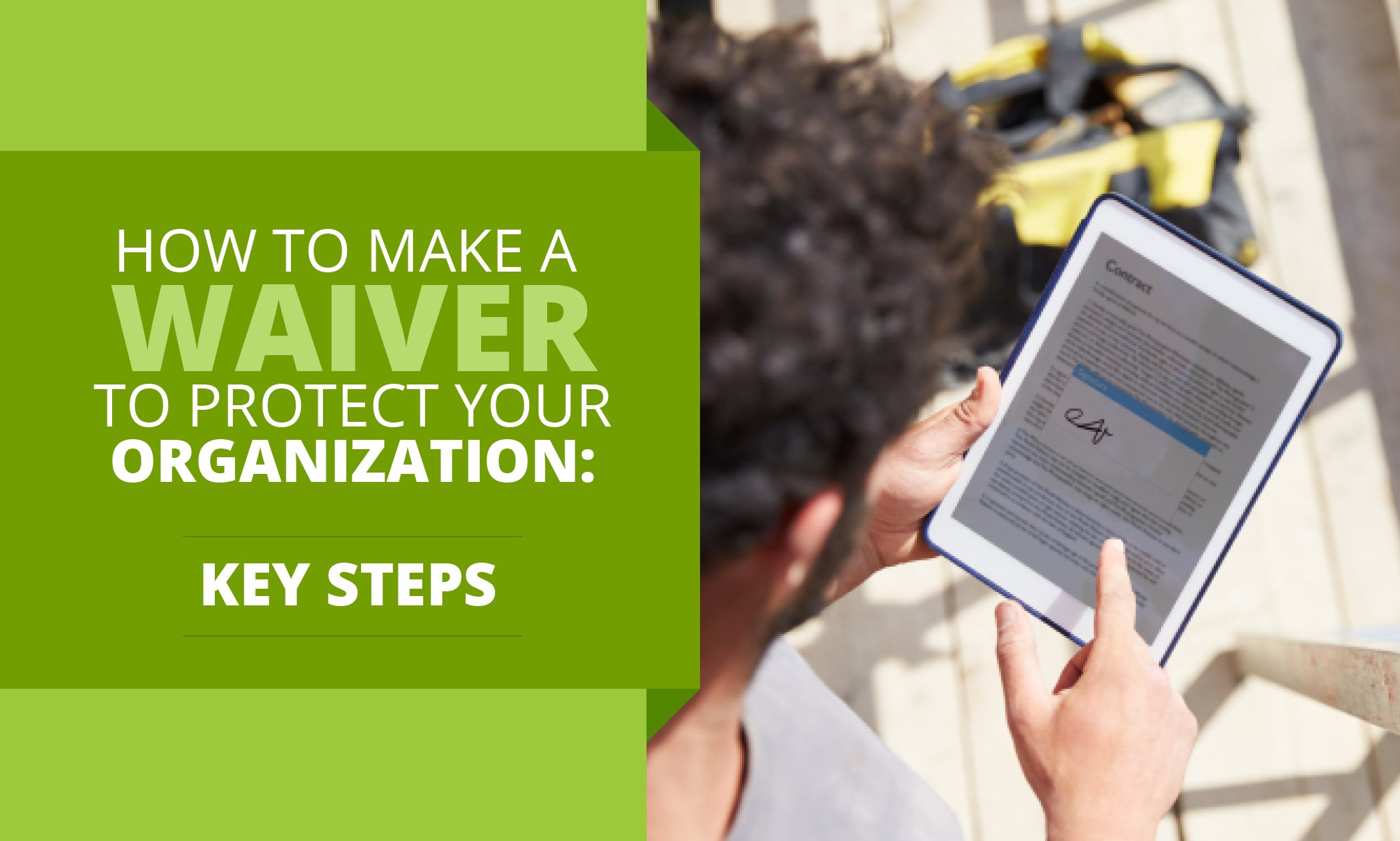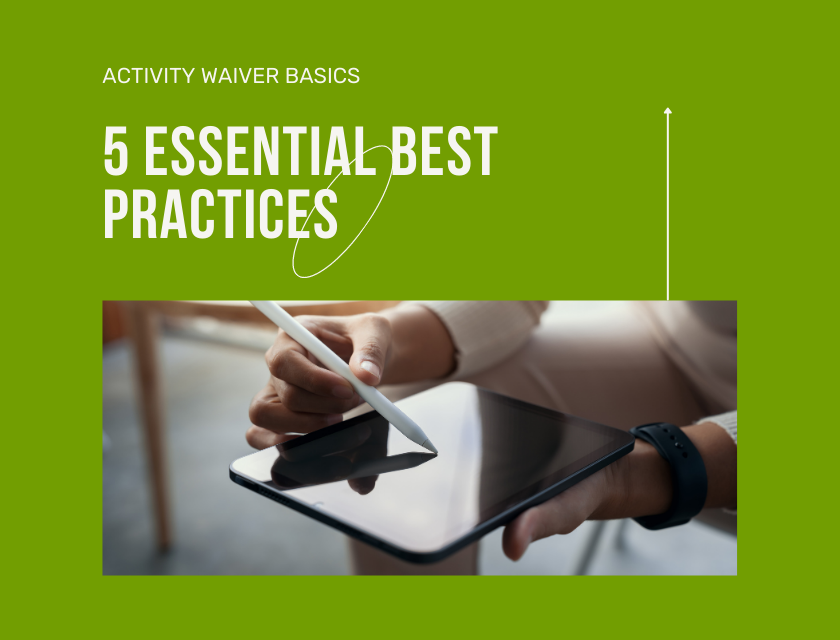Businesses, nonprofits, schools, youth sports teams, and many other organizations use waivers to protect their well-being and that of their members. However, creating waiver forms and obtaining signatures is a pain point for many organizations, particularly with traditional paper waivers. And if you ever need to find a paper waiver to reference, combing through a file cabinet can be inefficient and time-consuming.
Waiver software mitigates the stress of administering waivers. In this guide, we’ll cover the basics of waiver software and the top features to look for when choosing a provider.
Digital Waiver Basics
What is a digital waiver?

Waivers are legal documents that are typically used to obtain a release of liability from those who sign them. They also make participants more aware of the risks associated with the activity or event they will be participating in. Because the legality of waivers can vary based on local laws, it’s best to work closely with a lawyer when drafting and using waivers.
A digital waiver, also called an online waiver, contains the same key elements as a traditional waiver but can be accessed and signed online. While paper waivers procure “wet signatures” (those made via pen and paper), online waivers obtain electronic signatures (those transmitted electronically).
Online waivers are a more convenient alternative to paper waivers. For example, if your nonprofit is preparing for a large volunteering event, having each volunteer sign a paper waiver on-site could eat into the time they have to work. Instead, you might send each registrant a link to the online waiver beforehand so they can complete it prior to the event.
What are the benefits of waiver software?
While it’s common to associate waivers with risky activities like zipline jungle tours or kayaking excursions, they are used every day by many different kinds of organizations. For example, here are some scenarios where an organization would use a waiver:
- A nonprofit organization asks participants to sign waivers before competing in its charity 5K.
- A school sends waivers and permission forms to parents before taking students on a field trip.
- A youth sports team requires players’ parents to sign waivers before the athletes can compete or attend practices.
- A local gym requests that customers sign a waiver before joining group fitness classes or booking an appointment with a personal trainer.
In addition to securing a liability release, online waiver software has other benefits such as:

- Easy waiver management. Because they are stored virtually rather than in a file folder, organizing digital waivers is faster and easier. Data is also more secure when housed in a protected database, and it’s easy to find any individual waiver just by searching for a name or date. Additionally, your organization can make the most of the data collected via waivers, like using engagement history to personalize marketing efforts.
- Better user experiences. Users can sign the document from any device (mobile phone, tablet, desktop, etc.), making it much more convenient to complete the waiver ahead of time. They also won’t need to print or send a hard copy. If users forget to sign in advance, your organization can set up on-site kiosks at your event to ensure waiver completion.
- Increased accessibility. It’s much easier to make accessibility-based changes when using digital waivers. Your organization can update things like font size and language in just a few clicks. And because they can access waivers in advance, users can take all the time they need to read over the terms or get help from a caregiver or screen reader.
Online waivers can even make your organization more sustainable by reducing paper use (and, as a result, printing-related costs). The next step to taking advantage of these benefits is choosing a trusted waiver software provider.
Can you create your own waiver?
Yes, you can create your own waiver, especially when you have the right digital waiver software to help you out. We do recommend you work with a lawyer to write the waiver. They’ll be the best source of information on local regulations and have the expertise needed to draft legally binding documents.
From there, you just need to make the digital waiver by loading that language into your waiver software of choice. In the upcoming sections, we’ll discuss what you need to look for in the tool, starting with a user-friendly form builder.
8 Features to Look for In Digital Waiver Software

1. Intuitive Form Builder
Whether you’re converting a paper form into a digital waiver or starting from scratch, an easy-to-use form builder is a must. Ideally, the form builder should allow you to:
- Add unlimited custom fields and questions to suit your operational needs
- Insert signature and initial boxes wherever they’re needed
- Allow users to toggle between different languages (e.g., English, French, Spanish, or simplified Chinese)
Smartwaiver’s Waiver Editor is designed to be user-friendly and adaptable, allowing you to edit the templates at any time. Plus, you can have our team convert your existing waivers into digital Smart Waivers for you, saving your team time.
2. Flexible Customization Options
Your organization will likely need to customize the waiver to its niche, whether you run a summer camp, a boat rental company, or a nonprofit. For example, let’s say a business offers river rafting tours, and families with children make up a significant portion of its customer base. Minors obviously can’t waive liability, so their parents would need to complete the form, but how can the business adapt the form in this scenario?
We recommend looking for these capabilities:
- Parent/guardian relationship designations. To solve for the example listed above, choose a provider that allows you to have users indicate who will be participating in the activity: adults, minors, or adults and minors. From there, they’ll be directed to the appropriate form. Parents or guardians will fill out the form and give consent on behalf of the minors they are responsible for.
- Flagged questions. When these questions are answered a certain way, the waiver will be flagged in your database. For example, you might ask if the participant has any special needs or allergies. In this case, you would set up the question so that if a user checks “Yes,” the waiver will be flagged. Then, you can easily identify and follow up with those with special needs.
- Safety and instructional videos. Certain activities require participants to have training before they can join in. Maintain compliance with local regulations or business standards by embedding safety and training videos directly into the waiver form. Require users to review the video before they can submit the waiver to satisfy safety requirements.
Customization features like these cultivate a more seamless experience for your customers. Rather than reviewing training materials as a separate process, for example, you can integrate custom videos into the waiver.
3. Driver’s License Scanning
Your customers’ driver’s licenses contain much of the information needed to complete waivers. Take advantage of this by choosing software with a built-in driver’s license scanning tool. Use a barcode scanner to scan the barcode on the participant’s license, and the feature will automatically fill in the following information:

- Full name
- Address
- Gender
- Date of birth
- Driver’s license or ID card number
- Issuing state
This speeds up the process and makes completing the waiver more convenient for participants. Plus, responses will be more accurate with less room for human error (e.g., a user accidentally entering their address as 157 Club Court rather than 156 Club Court).
4. Waiver Kiosk App
While one of the key benefits of digital waivers is that customers can complete them ahead of time, not everyone will do this. You’ll need to provide an on-site alternative as a backup option.
Waiver kiosks allow you to collect digital waivers in person. Once you’ve set up an account with your digital waiver software provider, the process looks something like this:
- Download the waiver kiosk app to your tablet.
- Log in to your digital waiver software account from a computer and register the kiosk. The app should display a registration code.
- Adjust the settings on the tablet, such as designating an inactivity timeout limit, and choose which waivers you’d like to display to guests.
- Launch the waiver on the app and start collecting waivers!
Some waiver kiosk apps are able to collect waivers offline. This means that even if your business is in a remote location with a shaky internet connection, you can still safely store signed waivers.
5. Auto Photo Capture
If your organization uses waiver kiosks, you can equip auto photo capture tools. Here’s how Smartwaiver’s auto photo capture tools work:
- The participant begins signing the form using a waiver kiosk.
- Using the device’s built-in camera, the Smartwaiver app automatically snaps photos of the person signing at three points in the waiver signing process.
- The participant signs the waiver, and the photos are attached to the PDF copy of the form.
These photos add an extra layer of security and protection to the waivers, using real-time photos to verify signatures.
6. Secure Database
Waivers are important legal documents that can contain sensitive data, making data security a top priority. When comparing platforms, review the provider’s commitment to security. Are they practicing these digital security measures?:
- Data encryption
- Compliance with relevant security certifications (e.g., SOC 2 Type II)
- Two-factor authentication (2FA)
- A written pledge not to sell, share, or distribute data (i.e., a privacy policy)
- Role-based permissions that you can adjust to ensure only those who need access to signed waivers can access the data
- A certificate of authenticity for each signed waiver, assigning each form a unique document ID
Your waiver database should be secure and convenient to use. Look for providers that offer searchable databases so you can easily locate specific waivers by searching the participant’s name, birth date, date of attendance, etc.
7. Offline Functionality
Imagine this: your ziplining company is about to head out on a tour, and you’re waiting for the last few participants to submit their waivers via your waiver kiosk. Suddenly, the building loses its internet connection. You end up having to delay the tour until your connection is restored, but what if there were a better way?
As we mentioned earlier, some waiver kiosk apps can collect waivers without an internet connection. This is great for businesses that operate in remote locations or deal with unreliable connections, but let’s face it—internet outages can happen to any business. Choose software with an offline collection to give customers consistent, reliable experiences, ensuring they don’t even notice when your WiFi is on the fritz.
In most cases, all you’ll need to do is update your kiosk app to the latest version, toggle the offline capabilities “on,” and start collecting waivers. Once your device connects to the internet, the waivers collected offline will automatically sync to your database.
8. Integrations
Integrating your waiver software with your reservation, ticketing, or email marketing software will further streamline registration processes for your customers. Having an integrated tech stack also keeps your data consolidated, ensuring your database is always complete and up-to-date. Smartwaiver integrates with leading software providers for all kinds of industries—see if yours are included!
Wrapping Up
Investing in digital waiver software has a host of benefits for any organization that routinely uses waivers. With the help of waiver software and a legal professional, you can provide better experiences for those signing the liability waiver, all while reducing the time and effort you need to spend collecting and organizing.
To learn more about Smartwaiver’s solution and try it for yourself, check out our video demo and sign up for a free trial!
To get the most out of your waiver software, check out these resources:
- Industry-Leading Digital Waiver Features - Smartwaiver. If you’re curious about Smartwaiver’s features, explore this page for more details about our platform’s capabilities.
- Want a Free Online Waiver Signing Tool? Read This First. Considering a free digital waiver tool? Read this guide to learn about the red flags you might uncover with “free” software.
- How to Maximize Your Digital Waiver Software. Waiver software can do much more than manage liability releases. Discover the ways you can leverage software to benefit your organization.








